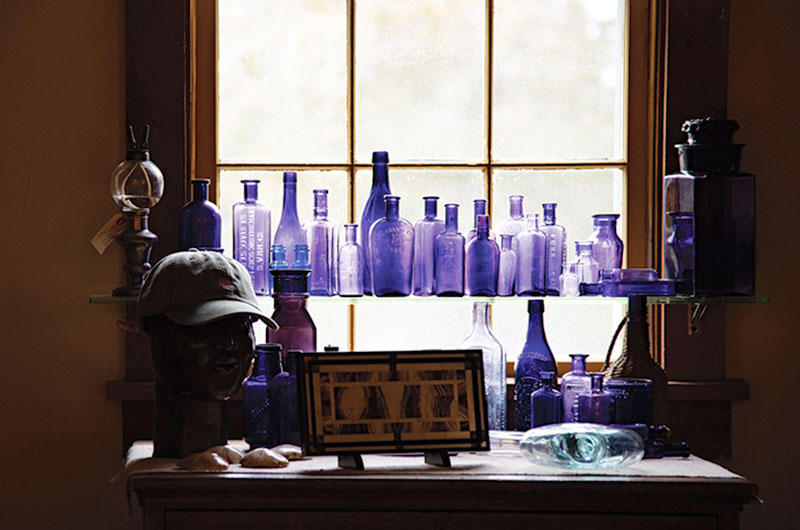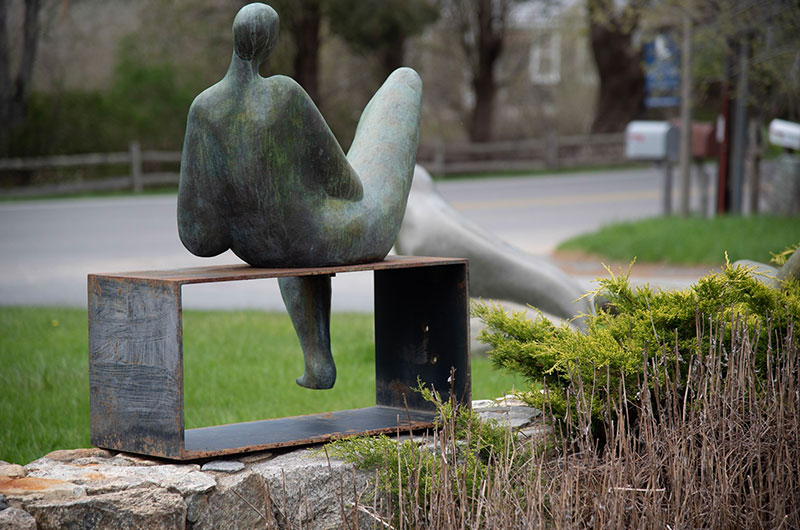In the summer of 1986, Chris Morse was between his freshman and sophomore years of college, working on a painting crew on the Vineyard – painting Ernie Boch’s house on Edgartown Harbor in fact. A friend on the crew said, “On Sunday, if you and your date come to the Granary Gallery where I’m bartending, I’ll serve you both champagne.” That was an offer too good to pass up for an 18-year-old.
The next summer, Chris took over as bartender at the Granary’s art openings, and wound up working the floor at the gallery too during the rest of his college summers.
Now Chris is the owner of the Granary Gallery and the Field Gallery in West Tisbury, and the North Water Street Gallery in Edgartown. How did he get from there to here?
Q: So a serendipitous visit to the Granary Gallery sparked something in you. But what was its origin?
A. I always had an interest in collecting. I had collections of collections, basically – everything from stamps and coins (the normal things) to beer cans or whatever! One of my earliest memories of appreciating art was with my stamp collection, studying all the different designs and landscapes. I also think my grandmother was an influence.
Q. Your grandmother?
A. My father’s mother was a weekend painter, and so when my sisters and I would stay over at her house we’d spend time in her studio and she’d have us play with either acrylics or watercolors. She’d teach us some of the basics of composition, of color and light, why there’s a light side and a dark side to a tree standing in the woods, that kind of thing.
Q. So after working summers through your college years, you came back to live on the Vineyard?
A. Yes, I loved working at the gallery. Got there early and stayed late and enjoyed talking to the artists and patrons. So I worked at the gallery in-season and took odd jobs in the winters. Eventually the owners, Bruce Blackwell and Brandon Wight, began to consider retirement and were thinking of selling the business. I saw a lot of potential in the gallery as the Vineyard was becoming more of a year-round place. I had met Sheila, who is now my wife. She shared my vision for the Granary and in 1996 we were able to put financing together and buy the business.
Q. What made you think you’d be successful?
A. I had a degree in business administration so I knew how to create a business plan. I ran a lot of scenarios – best case to worst case. I just couldn’t see the Granary Gallery really failing. So the worst case was still survival. Still, it was scary. It was probably only in the second summer that Sheila and I looked at each other and said, “We’re going to make it.”
Q. What is more important to a gallery’s success – its artists or its clients?
A. I think I am lucky to have the artists. Others might think the artists are lucky to have their gallery. I focus on doing a good job for the artist rather than the artist doing a good job for me.
Clients matter too, of course. It’s humbling and very gratifying to me that I am now selling art to the kids of parents I sold art to thirty years ago.
Q. Along the way you also became an art collector. How did that happen?
A. In the early days when the gallery used to close down during the off-season and we lived in the apartment upstairs, we brought up a statue of Ella Tulin’s Natasha , a 24-inch bronze, and put it on our coffee table. We lived with it all winter. Spring came and we brought it back down and it felt so strange. Natasha soon became the first major art purchase that Sheila and I bought together.
Q. How do you go about choosing new works for your collection?
A. Island art has always been a big focus of mine. This past winter through an estate, I came across (and bought) a painting of Alley’s General Store by Steve Mills. I had had a part in selling that to benefit the (MV) Preservation Trust when they were buying Alley’s. My most recent addition is the last painting Ray Ellis ever did. I bought it because it was the last. So the paintings I collect have to mean something to me.
Q. What are you doing now that you can’t travel to find art for the gallery?
A. It’s not a problem. There are a lot of auctions going on. We also work with other galleries whose season is opposite ours, say in Palm Beach, and get paintings from them. We’re also sourcing a lot of interesting new work remotely and from Vineyard homes.
Q. And everyone is dying to know if Thomas Hart Benton’s Going West is still in the Granary or someplace else?
A. We sold it! And all I can tell you is that it’s somewhere in the Northeast.
Q. What do you think this summer will be like for your business?
A. We’re always prepared to weather storms, and that’s what this summer’s going to be, very unusual. We’re prepared to not have group receptions. We’re looking at various ways to display our work virtually and working a lot with our social media team. It’s a different landscape now. We’ll adapt. We’ll be fine. We’re hopeful that our patrons will realize that the piece of artwork on the wall behind your Zoom call brightens up everyone’s day.














Comments